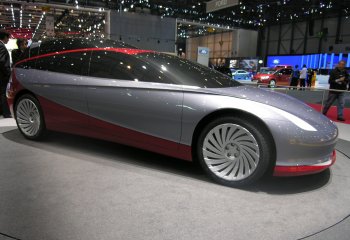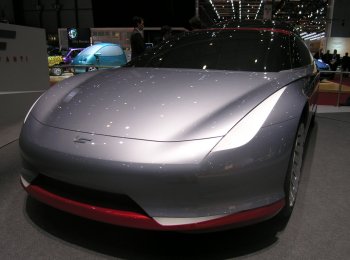|
Located in
the historic town centre of Moncalieri, design studio Fioravanti are renowned for
their innovative yet minimal answers towards advanced
packaging in car design. The studio was founded in 1987
by Leonardo Fioravanti, one
of the great Italian car designers, and recognised for
many classic Ferrari’s during his time at
Pininfarina including the
sensual 365 GTB/4 “Daytona” and the brutal 288 GTO. With
this lineage, the talented
Fioravanti design studio also has the flair to
present sleek avant-garde styling solutions to any
format of car.
The studio
unveiled their latest concept car, called the
Thalia, at the Geneva Motor
Show. The design presents a form study with
theoretically environmental pretensions, submitting an
unconventional solution as how to package alternative
energy technology.
The overall dimensions of the Thalia measure similar to an E-segment
estate with a 2900 mm wheelbase, however the rear
seating has been heightened by around 30 cm to form an
individual compartment with unique front windscreen for
the rear passengers. This affords the passengers a
superb view of the road ahead. The driver and front
passenger retain a sporty and reclined driving position,
a characteristic which is reinforced by the sleek
exterior design recalling
Fioravanti’s F100 Ferrari proposal of 1998.
|
 |
|
The rear seating of the Thalia has
been heightened by around 30 cm to form an
individual compartment with unique front windscreen
for the rear passengers. |
|
 |
|
|
 |
|
The Fioravanti concept design
presents a form study with theoretically
environmental pretensions, submitting an
unconventional solution as how to package
alternative energy technology. |
|
 |
|
|
Underneath
the highly positioned rear seats, hypothetically lies
the latest alternative energy technology. The space
generated underneath the seats leaves the possibilities
for hydrogen tanks for fuel cell technology, or even
batteries for an electric or hybrid engine. The low and
central positioning of these technologies would result
in a protective area, safe for crashes, and also
generating an ideal centre of gravity for superior handling.
At the rear,
an interesting asymmetrical trim incorporates the fog
and reverse lamps, as well as the window wiper and
tailgate release handle. True to the aerodynamic
pretensions of the car, the rear view mirrors have been
substituted for cameras in the rear spoiler.
by James Granger
|
|
|
|